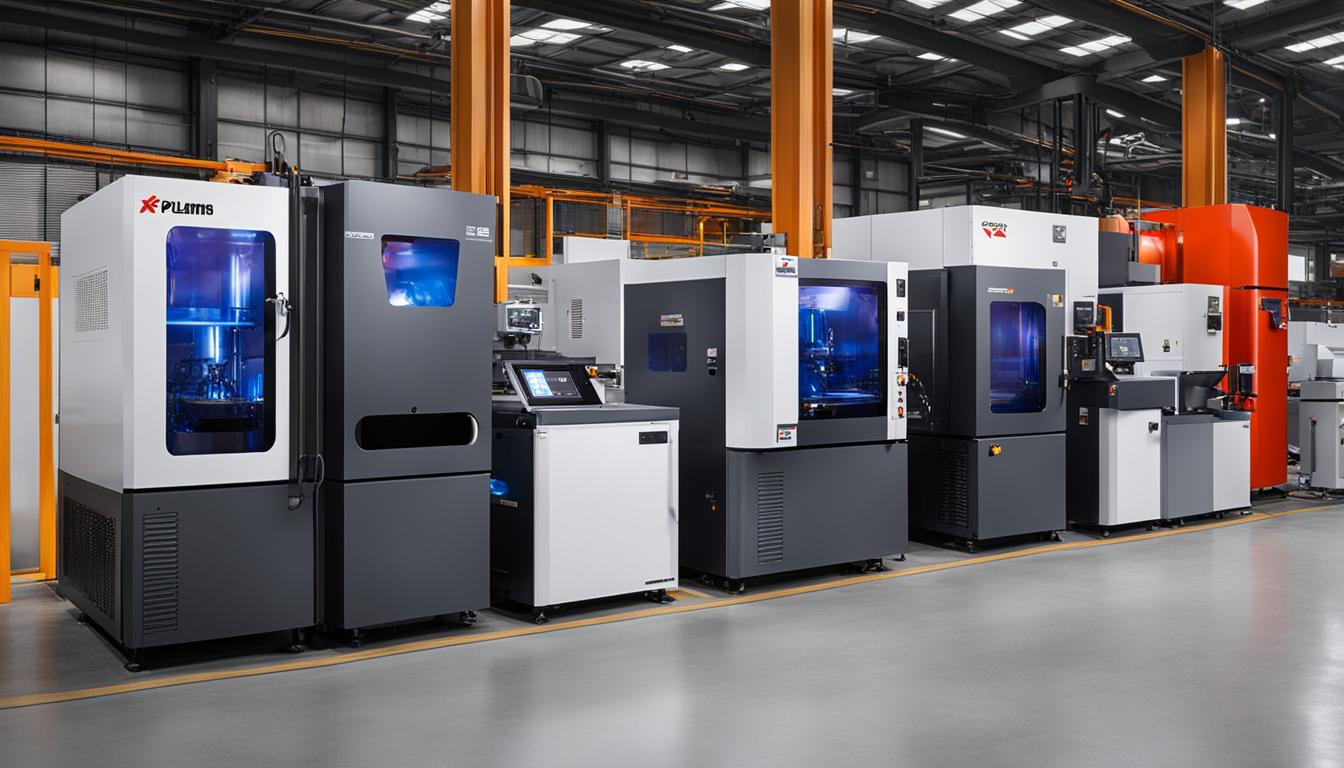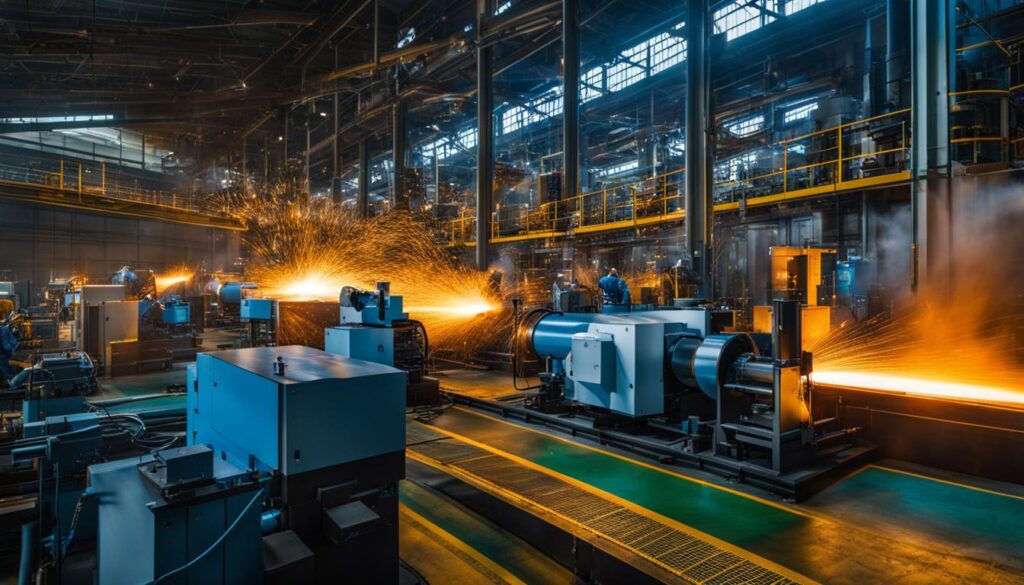
Plasmas are a widely used technology in various commercial sectors, offering advanced capabilities for manufacturing, healthcare, and energy applications. Plasma technology has revolutionized these industries, providing precise and controlled processes with exceptional outcomes.
In manufacturing, plasma processing technology is extensively employed for surface treatment, such as cleaning, etching, and coating. It enables high precision and fast processing speeds, making it invaluable in industries like semiconductor manufacturing, aerospace, automotive, and electronics. The versatility of plasma technology allows for the processing of a wide range of materials with exceptional results.
In the healthcare industry, plasma technology plays a vital role in sterilization, wound healing, and medical diagnostics. Plasma sterilization is a highly effective method for deactivating bacteria, viruses, and other pathogens. Plasma-based wound healing promotes tissue regeneration and accelerates the healing process. Additionally, plasma diagnostics offer non-invasive testing methods for early disease detection.
When it comes to power production, plasmas hold immense potential. Fusion reactors, utilizing deuterium-tritium plasma, have the capability to generate substantial amounts of energy. Although achieving net power output requires reaching plasma temperatures of approximately 100,000,000 K and high particle density with extended containment time, significant advancements have been made in this field.
Key Takeaways:
- Plasma technology is widely used in commercial sectors such as manufacturing, healthcare, and energy.
- Plasma processing technology enables precise surface treatment, with applications in industries like semiconductor manufacturing, aerospace, automotive, and electronics.
- Plasma technology plays a vital role in healthcare for sterilization, wound healing, and medical diagnostics.
- Plasmas have the potential to be used in power production, particularly in fusion reactors, although further advancements are needed to achieve net power output.
Plasma Technology in Power Production
Plasma technology is a key player in power production, particularly in the realm of fusion reactors. These reactors utilize deuterium-tritium plasma to unlock the potential for generating vast amounts of energy. While the achievement of net power output requires specific conditions, significant progress has been made by researchers in this field.
To harness the potential of plasma-based energy systems, certain parameters must be met. This includes achieving plasma temperatures of approximately 100,000,000 K and maintaining a high particle density with an extended containment time of about 1020 seconds per cubic meter.
While these desired figures have yet to be fully realized, researchers are dedicated to advancing plasma technology in power production. The ongoing efforts to meet the required plasma temperatures and particle density are driving breakthroughs and expanding our understanding of plasma physics.
“Plasma-based energy systems hold immense promise for the future of power generation. Although significant challenges remain, advancements in plasma temperatures, particle density, and containment time bring us closer to a sustainable and clean energy future.”
Table: Progress in Plasma Technology for Power Production
| Parameter | Target | Current Progress |
|---|---|---|
| Plasma Temperature (K) | 100,000,000 | In progress… |
| Particle Density (per cubic meter) | 1020 | In progress… |
| Containment Time (seconds) | 1020 | In progress… |
Image:
Plasma Technology in Manufacturing and Surface Treatment
Plasma processing technology is revolutionizing the manufacturing and surface treatment industries. With its unique capabilities, plasma technology allows for precise and controlled modifications to materials, making it a valuable tool for a wide range of applications.
One of the key advantages of plasma processing technology is its ability to perform surface cleaning, etching, coating, and deposition with exceptional precision. By using a plasma, manufacturers can achieve high-quality finishes and enhance the performance of their products.
Plasma technology is widely employed in various industries such as semiconductor manufacturing, aerospace, automotive, and electronics. In the semiconductor industry, plasma processing is used for thin film deposition and etching, enabling the production of smaller, faster, and more efficient chips.
Additionally, plasma technology plays a critical role in the aerospace and automotive sectors. It allows for the surface treatment of components, improving their durability, corrosion resistance, and adhesion properties. This contributes to the development of lightweight and fuel-efficient aircraft, as well as safer and more durable automobiles.
In the electronics industry, plasma technology is utilized for precise surface cleaning, removing contaminants and promoting the adhesion of coatings and adhesives. This ensures the reliable performance of electronic devices, such as smartphones, tablets, and computers.
Plasma processing technology offers fast processing speeds and the ability to work with a wide range of materials, including polymers, metals, ceramics, and composites. This versatility makes it an invaluable tool for manufacturers seeking to enhance their product quality and efficiency.

| Industry | Applications |
|---|---|
| Semiconductor | Thin film deposition, etching |
| Aerospace | Surface treatment for enhanced durability, corrosion resistance, and adhesion properties |
| Automotive | Surface treatment for improved performance and longevity |
| Electronics | Precise surface cleaning and preparation for reliable performance |
Plasma Technology in Healthcare
Plasma technology plays a crucial role in healthcare, revolutionizing sterilization, wound healing, and medical diagnostics. Leveraging the unique properties of plasma, this advanced technology offers innovative solutions that address the challenges faced by the healthcare industry.
Plasma Sterilization: Safe and Effective Pathogen Deactivation
Plasma sterilization is a cutting-edge method for deactivating bacteria, viruses, and other pathogens. With its ability to penetrate complex surfaces and delicate instruments, plasma sterilization provides a thorough and effective disinfection process. It offers a safe alternative to traditional sterilization methods, eliminating the risks associated with heat, chemicals, and radiation. This makes plasma sterilization a valuable tool in healthcare settings, ensuring the safety of patients and healthcare professionals.

Wound Healing Applications: Accelerating the Regeneration Process
Plasma technology shows great promise in wound healing applications. By generating plasma jets, this technology promotes tissue regeneration and accelerates the healing process. The plasma jets deliver controlled energy to the wound site, stimulating cell growth and promoting the formation of new blood vessels. This innovative approach has the potential to revolutionize wound care, allowing for faster healing, minimizing scarring, and enhancing patients’ quality of life.
Plasma-based Diagnostics: Non-invasive Early Disease Detection
Plasma-based diagnostics offer exciting possibilities for non-invasive testing methods in healthcare. By analyzing blood samples, plasma diagnostics can detect biomarkers and provide valuable insights into early disease detection. This enables healthcare professionals to intervene at an early stage, potentially improving patient outcomes and reducing the burden on healthcare systems. With ongoing research and advancements in plasma-based diagnostics, a future where diseases can be detected earlier and more accurately is within reach.
Advantages of Plasma Technology in Healthcare:
- Precise and effective sterilization
- Accelerated wound healing and tissue regeneration
- Non-invasive diagnostics for early disease detection
- Reduced risks compared to traditional methods
- Potential to improve patient outcomes
Applications of Plasma Technology in Healthcare
| Application | Benefits |
|---|---|
| Sterilization | – Deactivates pathogens effectively – Safe alternative to traditional methods |
| Wound Healing | – Accelerates tissue regeneration – Minimizes scarring – Enhances healing outcomes |
| Diagnostics | – Non-invasive testing – Early disease detection – Improved intervention strategies |
Plasma technology continues to advance and reshape healthcare practices. With its wide range of applications and growing potential, plasma technology holds the key to transforming the future of healthcare.
How is Plasma Technology Used in Smoke Detection Systems?
Plasma technology is one of the most advanced types of smoke detection technologies, offering faster and more accurate fire detection. By utilizing ionized gas to detect smoke particles, plasma-based systems can quickly identify potential fires and alert occupants, making them a crucial component of modern fire safety measures.
Conclusion
Plasma technology has revolutionized various industries, unlocking new possibilities and driving advancements in manufacturing, healthcare, and energy sectors. Its commercial applications continue to expand, contributing to innovation and progress in these industries. From power production to surface treatment, plasma has proven to be a valuable tool with immense potential.
In manufacturing, plasma processing technology offers precise and controlled modifications to materials, enabling surface cleaning, etching, coating, and deposition. This technology enables high precision, fast processing speeds, and compatibility with a wide range of materials, making it indispensable in industries such as semiconductor manufacturing, aerospace, automotive, and electronics.
The impact of plasma technology in healthcare is equally significant. Plasma sterilization has emerged as an effective method for deactivating pathogens, including bacteria and viruses. Additionally, plasma-based wound healing applications promote tissue regeneration and expedite the healing process. Non-invasive plasma-based diagnostics also provide early disease detection, contributing to improved healthcare outcomes.
Looking ahead, as technology and research continue to advance, new and exciting applications of plasma are expected. With its unique capabilities and versatility, plasma is set to strengthen its position as a key tool in commercial plasma applications. As industries further harness the potential of plasma-based industries, we can anticipate even greater achievements and breakthroughs in the future.








